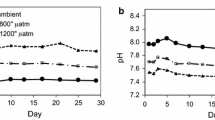Abstract
Data on the bacterial and primary production, which were obtained simultaneously for the same water samples, are presented for three regions of the Kara Sea. The samples were collected for the transect westwards of the Yamal Peninsula, along the St. Anna Trough, and the transect in Ob Bay. Direct counts of the DAPI-stained bacterial cells were performed. The bacterial production and grazing rates were determined using a direct method when metabolic inhibitors vancomycin and penicillin were added. The primary production rates were estimated using the 14C method.
The average primary production was 112.6, 58.5, and 28.7 mg C m−2 day−1, and the bacterial production was 12.8, 48.9, and 81.6 mg C m−2 day−1 along the Yamal Peninsula, the St. Anna Trough, and Ob Bay, respectively. The average bacterial carbon demand was 34.6, 134.5, and 220.4 mg C m−2 day−1 for these regions, respectively. The data obtained lead us to conclude that the phytoplankton-synthesized organic matter is generally insufficient to satisfy the bacterial carbon demand and may be completely assimilated via the heterotrophic processes in the marine ecosystems. Therefore, the bacterial activity and, consequently, the amount of the synthesized biomass (i.e., the production) both depend directly on the phytoplankton’s condition and activity. We consider these relationships to be characteristics of the Kara Sea’s biota.
Similar content being viewed by others
References
V. I. Vedernikov, A. B. Demidov, and A. I. Sud’bin, “Primary Production and Chlorophyll in the Kara Sea in September 1993,” Okeanologiya 34(5), 693–703 (1994).
G. G. Vinberg, Yu. G. Kabanova, O. I. Koblents-Mishke, et al., Guidelines to Determination of Primary Production of Organic Matter in Water Bodies by the Radiocarbon Method (Izd. Belorus. Univ., Minsk, 1960) [in Russian].
M. E. Vinogradov, V. I. Vedernikov, E. A. Romankevich, and A. A. Vetrov, “Components of the Carbon Cycle in the Russian Arctic Seas: Primary Production and Flux of Corg from the Photic Layer,” Okeanologiya 40(2), 221–233 (2000) [Oceanology 40 (2), 204–215 (2000)].
M. E. Vinogradov and E. A. Shushkina, Functioning of Planktonic Communities in the Epipelagic Zones of the Ocean (Nauka, Moscow, 1987) [in Russian].
I. N. Mitskevich and B. B. Namsaraev, “Abundance and Distribution of Bacterioplankton in the Kara Sea in September 1993,” Okeanologiya 34(5), 704–708 (1994).
N. D. Romanova and A. F. Sazhin, “Relationship between the Volume of a Bacterial Cell and the Content of Carbon in It,” Okeanologiya 50(4), 556–565 (2010).
I. N. Sukhanova, “Report of the Phytoplankton and Primary Production Team,” in Report on Work in Cruise 54 of R/V “Akademik Mstislav Keldysh”, Vol. 3: Team Leader Reports (Archive of Institute of Oceanology, Russian Academy of Sciences, 2007), pp. 29–38.
I. N. Sukhanova, M. V. Flint, S. A. Mosharov, and V. M. Sergeeva, “Phytoplanktonic Community Structure and Primary Production in the Ob Estuary and in Adjacent Shelf,” Okeanologiya 50(5), 785–800 (2010).
M. V. Flint, “Cruise 54 of R/V “Akademik Mstislav Keldysh” in the Kara Sea,” Okeanologiya 50(5), 677–682 (2010).
R. M. W. Amon and B. Meon, “The Biogeochemistry of Dissolved Organic Matter and Nutrients in Two Large Arctic Estuaries and Potential Implications for Our Understanding of the Arctic Ocean System,” Mar. Chem. 92, 311–330 (2004).
D. A. Caron, “Technique for Enumeration of Heterotrophic Nanoplankton Using Epifluorescence Microscopy, and Comparison with Other Procedures,” Appl. Environ. Microbiol. 46, 491–498 (1983).
J. J. Cole, S. Findlay, and M. L. Pace, “Bacterial Production in Fresh and Saltwater Ecosystems: A Cross-System Overview,” Mar. Ecol. Prog. Ser. 43, 1–10 (1988).
H. W. Ducklow and C. A. Carlson, “Oceanic Bacterial Production,” Adv. Microb. Ecol. 12, 113–181 (1992).
H. W. Duclow and F. K. Shiah, Aquatic Microbiology: An Ecological Approach, Ed. by T. G. Ford (Blackwell Scientific Publications, Boston, 1993), pp. 261–287.
J. E. Hobbie, R. J. Daley, and S. Jasper, “Use of Nucklepore Filters for Counting Bacteria by Fluorescence Microscopy,” Appl. Environ. Microbiol. 35(5), 1225–1228 (1977).
K. A. Hoff, Handbook of Methods in Aquatic Microbial Ecology, Ed. by P. F. Kemp et al. (Lewis Publ., Boca Raton, Fla., 1993), pp. 149–154.
O. Holm-Hansen and B. Riemann, “Chlorophyll a Determination: Improvements in Methodology,” Oikos 30, 438–447 (1978).
B. Meon and R. M. W. Amon, “Heterotrophic Bacterial Activity and Fluxes of Dissolved Free Amino Acids and Glucose in the Arctic Rivers Ob, Yenisei and the Adjacent Kara Sea,” Aquat. Microb. Ecol. 37, 121–135 (2004).
T. Nagata, Microbial Ecology of the Oceans, Ed. by D. L. Kirchman (Wiley, New York, 2000), pp. 121–152.
J. C. Nejstgaard, L. J. Naustvoll, and A. F. Sazhin, “Correcting for Underestimation of Microzooplankton Grazing in Bottle Incubation Experiments with Mesozooplankton,” Mar. Ecol. Progr. Ser. 221, 59–75 (2001).
S. Pabi, G. L. van Dijken, and K. L. Arrigo, “Primary Production in the Arctic Ocean, 1998-2006,” J. Geophys. Res. 113(C08005), doi:10.1029/2007JC004578 (2008).
R. B. Rivkin, M. R. Anderson, and Lajzerowicz, “Microbial Processes in Cold Ocean. 1. Relationship between Temperature and Bacterial Growth Rate,” Aquat. Microb. Ecol. 10, 243–254 (1996).
E. Sakshaug, The Organic Carbon Cycle in the Arctic Ocean, Ed. by R. Stein and R. W. Macdonald (Springer, Berlin, New York, 2004), pp. 57–81.
B. F. Sherr, E. B. Sherr, T. L. Andrew, et al., “Trophic Interactions between Heterotrophic Protozoa and Bacterioplankton in Estuarine Water Analyzed with Selective Metabolic Inhibitors,” Mar. Ecol. Prog. Ser. 32, 169–179 (1986).
D. V. Subba and T. Platt, “Primary Production of Arctic Waters,” Polar Biol. 3, 191–201 (1984).
T. Weisse, “The Microbial Loop in the Red Sea: Dynamics of Pelagic Bacteria and Heterotrophic Nanoflagellates,” Mar. Ecol. Prog. Ser. 55, 241–250 (1989).
Author information
Authors and Affiliations
Corresponding author
Additional information
Original Russian Text © A.F. Sazhin, N.D. Romanova, S.A. Mosharov, 2010, published in Okeanologiya, 2010, Vol. 50, No. 5, pp. 801–808.
Rights and permissions
About this article
Cite this article
Sazhin, A.F., Romanova, N.D. & Mosharov, S.A. Bacterial and primary production in the pelagic zone of the Kara Sea. Oceanology 50, 759–765 (2010). https://doi.org/10.1134/S0001437010050127
Received:
Accepted:
Published:
Issue Date:
DOI: https://doi.org/10.1134/S0001437010050127




